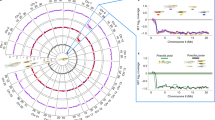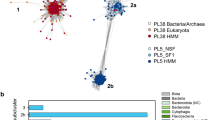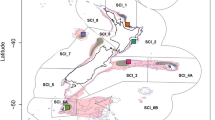Abstract
Large samples of a natural population of the plaice were examined for evidence of gametic disequilibrium (D) at five and seven polymorphic enzyme loci (younger and older fish respectively). A single pairwise locus comprison gave a statistically significant value for D: αGpdh-1 and Pgi-2 in young fish. The mean D values of the 10 pairwise comparisons of the five loci in young and old fish were low, 0.00175 and 0.00420 respectively: corresponding values of R (the correlation of gene frequencies) were 0.01473 and 0.03002. The increase in these parameters in older fish might be due either to population admixture, natural selection, a smaller sample size, or to a combination of these factors. The mean D and R values for the 21 pairwise comparisons of the seven loci typed in older fish were 0.00394 and 0.2496 respectively. Two loci catalysing adjacent steps in the glycolytic pathway, Pgm-1 and Pgi-2, showed no evidence of epistatic interactions generating disequilibrium.
Similar content being viewed by others
Article PDF
References
Bennett, J H. 1965. Estimation of the frequencies of linked gene pairs in random mating populations. Amer J Hum Genet, 17, 51–53.
Brown, A H D. 1975. Sample sizes required to detect linkage disequilibrium between two or three loci. Theor Pop Biol, 8, 184–201.
Cavalli-Sforza, L L, and Bodmer, W F. 1971. The Genetics of Human Populations. Freeman, San Francisco.
Charlesworth, B, Charlesworth, D, and Loukas, M. 1979. A study of linkage disequilibrium in British populations of Drosophila subobscura. Genetics, 92, 983–994.
Hedrick, P, Jain, S, and Holden, L. 1978. Multilocus systems in evolution. Evol Biol, 11, 101–184.
Hill, W G. 1974. Estimation of linkage disequilibrium in randomly mating populations. Heredity, 33, 229–239.
Hill, W G, and Robertson, A. 1968. Linkage disequilibrium in finite populations. Theor Appl Genet, 38, 226–231.
Kimura, M. 1956. A model of a genetic system which leads to closer linkage by natural selection. Evolution, 10, 278–287.
Langley, C H. 1977. Nonrandom associations between allozymes in natural populations of Drosophila melanogaster. In Christiansen, F. B. and Fenchel, T. M. (eds.) Measuring Selection in Natural Populations. Springer-Verlag, Berlin, pp. 265–273.
Macer, C T. 1972. The movements of tagged adult plaice in the Irish Sea. Fish Investig, London, Ser 2, 27(6), 41 pp.
Mitton, J B, and Koehn, R K. 1975. Genetic organization and adaptive response of allozymes to ecological variables in Fundulus heteroclitus. Genetics, 79, 97–111.
Mukai, T, Watanabe, T K, and Yamaguchi, O. 1974. The genetic structure of natural populations of Drosophila melanogaster. XII. Linkage disequilibrium in a large local population. Genetics, 77, 771–793.
Nass, C A G. 1959. The X2 test for small expectations in contingency tables, with special references to accidents and absenteeism. Biometrika, 46, 365–385.
Purdom, C E, Thompson, D, and Dando, P R. 1976. Genetic analysis of enzyme polymorphisms in the plaice (Pleuronectes platessa). Heredity, 37, 193–206.
Simpson, A C. 1959. The spawning of the plaice (Pleuronectes platessa) in the Irish Sea. Fish Investig, London, Ser 2, 22(8), 30 pp.
Sinnock, P, and Sing, C F. 1972. Analysis of multilocus genetic systems in Tecumseh, Michigan. II. Consideration of the correlation between nonalleles in gametes. Amer J Hum Genet, 24, 393–415.
Smouse, P E, Neel, J V. Multivariate analysis of gametic disequilibrium in the Yanomama. Genetics, 85, 733–752.
Thompson, G. 1977. The effect of a selected locus on linked neutral loci. Genetics, 85, 753–788.
Ward, R D, and Beardmore, J A. 1977. Protein variation in the plaice, Pleuronectesplatessa L. Genet Res, 30, 45–62.
Zouros, E, and Johnson, W. 1976. Linkage disequilibrium between functionally related enzyme loci of Drosophila mojavensis. Can J Genet Cytol 18, 245–254.
Author information
Authors and Affiliations
Rights and permissions
About this article
Cite this article
Ward, R., McAndrew, B. A search for gametic disequilibrium in the plaice, Pleuronectes platessa. Heredity 55, 105–110 (1985). https://doi.org/10.1038/hdy.1985.76
Received:
Issue date:
DOI: https://doi.org/10.1038/hdy.1985.76



